When Kei Yoshimizu redesigned Reiko Nagase and turned the character from a race queen to a mascot for Ridge Racer he had lofty goals for her. The CGI artist and animator was trying to convince the world that a female lead in a male dominated sport was long overdue. He had to break the perceptions from his fellow Japanese developers as well as those from the US. A woman could meet the Western ideals of femininity while also becoming a symbol for power and grace in the process. In order to do that she had to go against the grain. Her short haircut was not only fashion forward, it was something that would never have been expected of a female lead in any Japanese game, manga or animé. It would take more than a decade and a half before audiences became aware of the perspective that Kei and his RR Project members were going for.
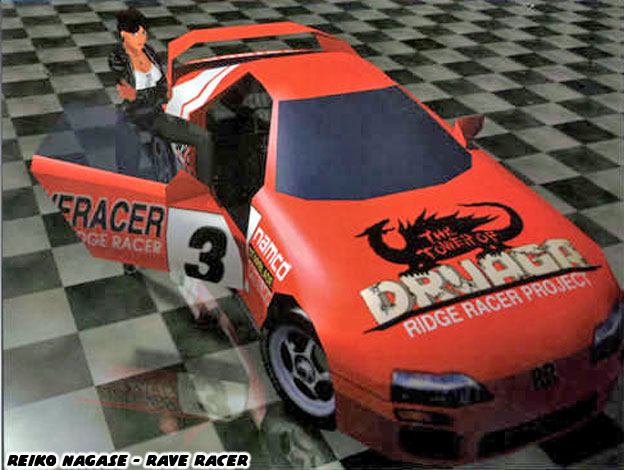
In the early Rave Racer flyers and promotional material Reiko was posed next to a race car. Yet she wasn't used exactly like a model would have been at an auto show or magazine spread. She wasn't laying in front of the car in a bikini, nor was she holding up a grid card. With arms crossed and a foot in the door Reiko stood defiant. Since it was a Japanese car Reiko was actually standing on the driver's side.
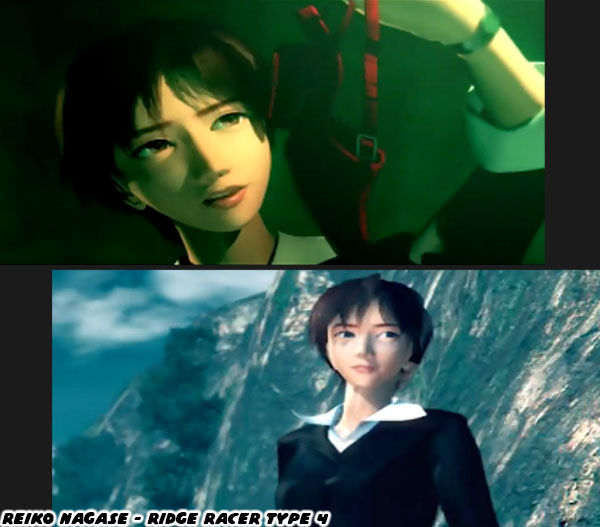
She was not posing next to A car, she was posing next to HER car. The pants and leather jacket were not part of some scantily corporate uniform. This was the real Reiko and this was her ride. Audiences seemed oblivious to this statement. All they had known for years and years was that the drivers were men because racing was a man's game. If a woman was in the title then she was just eye candy, a paddock girl and nothing more. Mr. Yoshimizu was very progressive when he changed the look and purpose of Reiko. If Namco was serious about developing a mascot for their racing franchise then she could not be a throw away character. Reiko had to have as much of a backbone as any action hero. From this point on Reiko would have to perform the double duty as a model and driver.
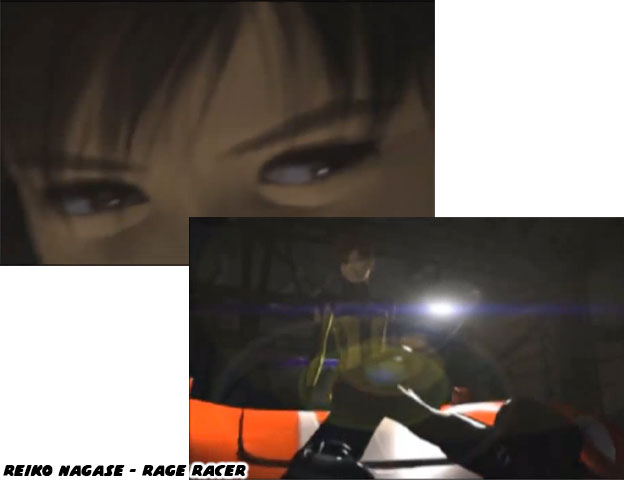
In the opening cinematic (attract screens had gone out of fashion for console games in the mid '80s) Reiko was actually shown sitting on the hood of the cover car in Rage Racer. The all red with white stripes Assoluto Fatalia was one of the most desirable fictional race cars in the series. She was wearing boots and a yellow uniform. Eagle-eyed players saw it was one of the dresses she would wear after she became a sponsored model. The dress looked like a blend of leather and Nomex, a fireproof material. The sharp yellow and black pattern could easilyhave doubled as her racing uniform. The pairing of Reiko with one of the fastest cars in the game was definitive of the series. It was a blend of style and substance that kept people coming back.
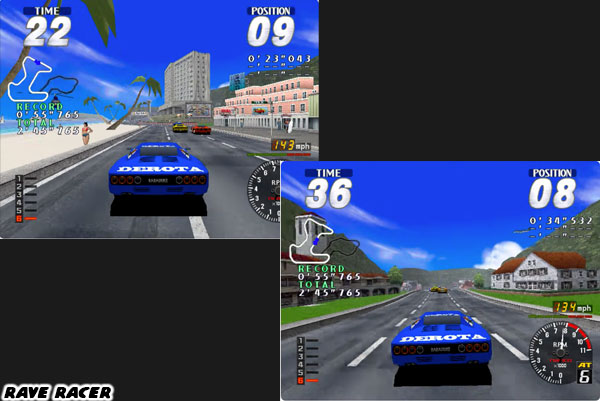
In future revisions of the series Namco did not want to make Reiko appear as a one-dimensional racing character. One that was never seen outside of her racing uniform, like Gina Cavalli or Rena Hayama from R: Racing Evolution. Reiko would be above all else a very feminine character. Mr. Yoshimizu would direct her in multiple openings for the series. Reiko's most memorable of course was
her 1999 feature debut in Ridge Racer Type 4. However there was a gap where she wasn't seen for the next few games. In fact
Gina appeared as the mascot on the Nintendo DS version of Ridge Racer in 2004 instead of Reiko.

When Reiko returned in Ridge Racers for the PSP later that year it was as if she had never left. The model was timing
a Soldat Raggio with a stopwatch while she was lying on top of a yellow Assoluto Fatalia. Without saying a word the character stepped down from her car barefoot. This was a nod to the heel she broke in the R4 opening. The character appeared absolutely charming as she met the Soldat on the road. A year later the game made it's debut on the Xbox 360. In the intro
to Ridge Racer 6 Reiko was seen lounging in her apartment and dreaming about racing. That build of the game got even more polish and was released on the Playstation 3 in 2006 as Ridge Racer 7. In the
new intro Reiko was seen modeling in front of a projector screen, pretending to take a leisurely drive.
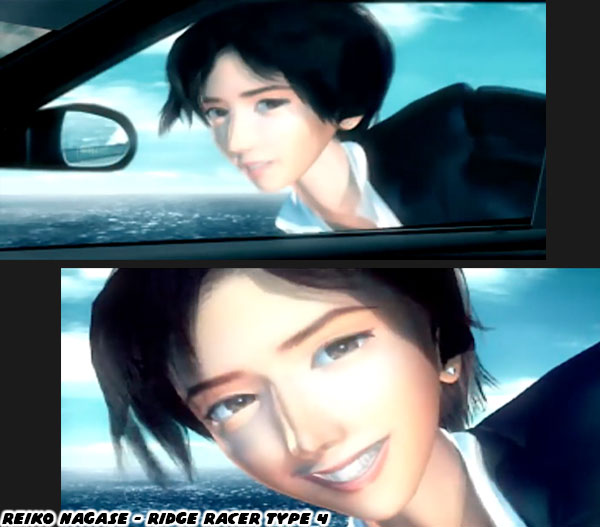
The same year that the Playstation 3 had their new Ridge Racer title Namco had released the PSP version of Ridge Racers 2. Sony was reaping the rewards of a long partnership with the company. Reiko had returned with stopwatch in hand to time another race. The model would appear on projector screens on several courses within the game. The most famous celebrity in Ridge City had become synonymous with the tournament. The personality of Reiko was fleshed out with every new video released by Namco. The one thing that had been lacking through most of the new millennium was a connection to her actual racing passion. The studio had forgotten that as playful and sexy as they wanted to present Reiko, she was still a driver at heart.
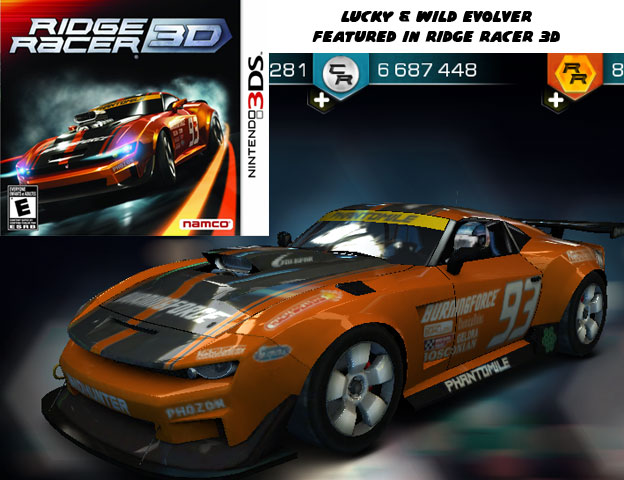
That finally came through in 2011 when the series made its debut on the Nintendo 3DS.
Reiko finally left her heels behind and put on a pair of sharp racing boots in Ridge Racer 3D. Every build of the series tended to highlight a particular manufacturer. Although they were all fictional it was still a sign of respect that the Japanese developers had shown the rest of the world. The European companies had gotten a lot of love over the past 20+ years and the USA was finally due for some attention. Reiko was driving the car featured on the box, the Lucky and Wild Evolver. In fact she was performing double duty on the track. She was also driving the final rival car in the game, the Lucky and Wild Marauder.
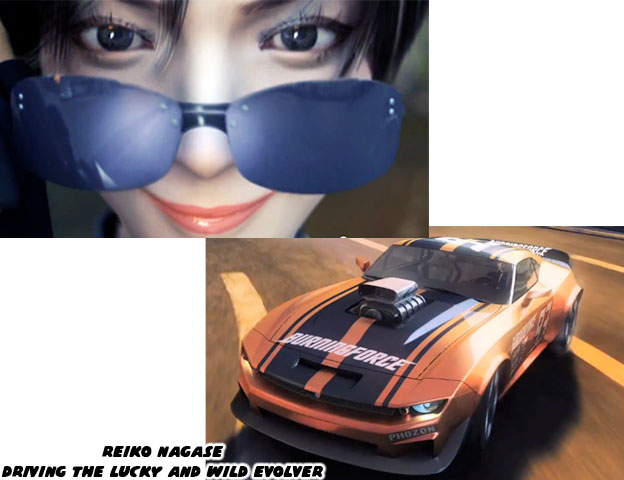
When Reiko had returned to the series Namco had found its second wind. The studio decided to go back to its roots and try to rebuild. Their goal was to define the Ridge Racer experience for the consoles. The Playstation 2, despite its advanced features had been dismal for the series. They had a lot of catching up to do when other racing games appeared out of nowhere to dominate the market. The definitive Ridge Racer title would take a decade to materialize. The development process would add entirely new chapters to the history of racing games. Some things worked and some did not. Some things would be copied by rival studios and some would better be left forgotten. The next part of the series will explore what happened to the genre while Namco was shifting their operations to focus on consoles rather than the arcade.
As always if you would like to sponsor me
please visit my Patreon page and consider donating each month, even as little as $1 would help make better blogs and even podcasts!
















Amazing all the thought that goes into the placement and even jobs for a character in the RR universe.
ReplyDelete